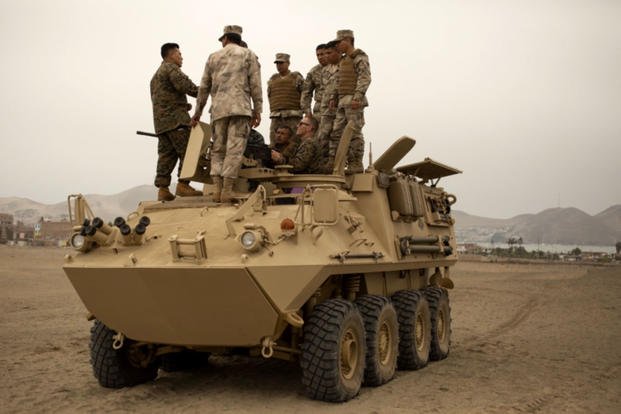As U.S. Marines gear up for another deployment to Latin America this year, the message from past ventures remains consistent: Look to the United States for assistance and growth.
Roughly 300 Marines and sailors with the Special Purpose Marine Air-Ground Task Force (SPMAGTF) rapid response team deployed to Soto Cano Air Base, Honduras, from June to November last year.
The group consisted of one third active-duty troops and two-thirds Reserve members, according to Col. Michael Oppenheim, who led the SPMAGTF-Southern Command on the 2018 deployment.
Oppenheim said the mission's objective, besides theater security and promoting interoperability during the hurricane season, was to demonstrate to South and Central American partners "that we are a partner of choice."
"And we hope to expand there," he told reporters at the Pentagon on Thursday.
"One of [Southern Command's] lines of effort is to reaffirm [that] the U.S. is a partner of choice -- certainly we're referring to the National Security Strategy, [where] we identify external state actors" who may not share common values, Oppenheim said.
U.S. officials have expressed concern in recent months that growing influence from countries such as Russia and China in the southern hemisphere may sideline regional stability.
During the 2018 deployment, Oppenheim said, U.S. leaders did not broach that topic specifically because they were focused on building alliances.
But "at the operational and strategic level at the combatant command, they do talk about the[se] issues," he added.
Related content:
- US Aims to Expand Military Partnerships in South America
- Cocaine Bust Highlights Growing Air Force Role in Southern Hemisphere
- US Troops Continue Central American Missions as Trump Vows to Pull Aid
The future vision for the team is a maritime "multinational task force that has a lot of burden-sharing from our partner nations, working hand-in-hand ... to get after common challenges and reinforce common values [such as] response to natural disasters ... and other types of illicit activities that are going on that are common challenges to all of us as citizens of the Americas," Oppenheim said.
Unlike an exercise such as UNITAS -- an annual U.S.-led maritime exercise that incorporates ships, aircraft and personnel from the U.S. and dozens of countries for a few days -- the SPMAGTF has a longer presence year-to-year.
Its deployments involve engineering and building projects with partners and prepping to provide emergency response in the event of a natural disaster or crisis. For example, the Marines assisted in wake of the Volcan de Fuego eruptions near Escuintla, Guatemala, last June, helping repair facilities and construct shelters.
When the unit deploys in the summer of 2019, it will be the fifth consecutive deployment, showing the Marines "have made strides," Oppenheim said.
The 2018 deployment marked the first time foreign senior officers -- including those from Chile, Colombia and Honduras -- integrated with top Marine leadership at the decision table. This summer, countries such as Mexico, Brazil, Peru and Argentina could join the operations.
"Because we were specifically tailor-made for this mission set, we already knew the projects in advance that the countries and the combatant commander ... had worked to agree on," Oppenheim said.
In previous deployments, which began in 2015, the Marines participated heavily in hurricane response. But in 2018, most of the hurricanes skirted the Caribbean and Central America.
"So we had more capacity," Oppenheim said. This allowed service members to expand their subject-matter-expert exchanges and security cooperation engagements with key leadership, which also included the U.S. Army, he said.
Additionally, SPMAGTF-SC worked with the U.S. Navy and Air Force on various elements -- including moving personnel and cargo via CH-53E Super Stallion helicopters to the dock landing ship Gunston Hall off the coast of Belize -- and especially Joint Task Force-Bravo, headquartered at Soto Cano.
"It enhanced our readiness ... and demonstrated our resolve to be a partner of choice, our willingness to work with partner nations, bring them into the fold, and frankly, do that type of job in a different type of environment [and] navigate the cultural terrain," Oppenheim said.
He said he does not foresee huge changes to the task force this year in terms of equipment or technologies.
"The type of work that we're doing doesn't really require the type of science or technology to do the types of things that we're doing," but he added there's always room to experiment as needed.
Oppenheim does, however, expect to see more partners coming into the fold and more collaboration.
"We're good partners, we play nice, we obviously reinforce things that are important to everybody ... and I can say that everybody wants more," he said, referring to more training opportunities in the Southern Command region.
"The demand signal was sent ... and I suspect similarly for the National Guard and our other sister services, because for the U.S. ... this is a good job for us to be working with our partners down south," Oppenheim said.
-- Oriana Pawlyk can be reached at oriana.pawlyk@military.com. Follow her on Twitter at @Oriana0214.













